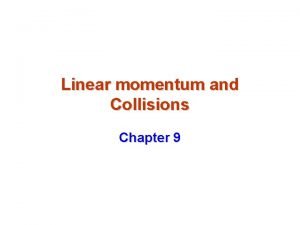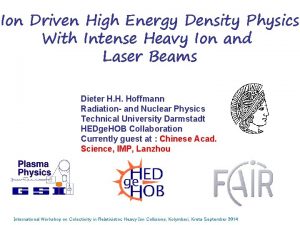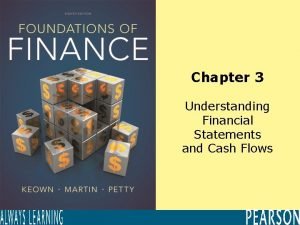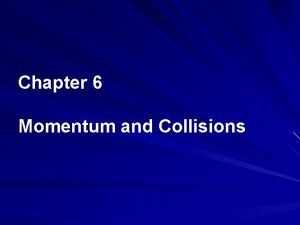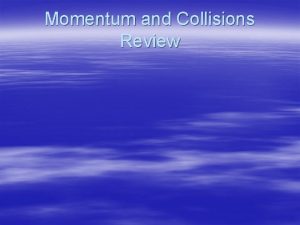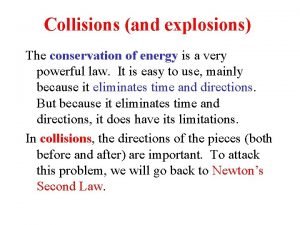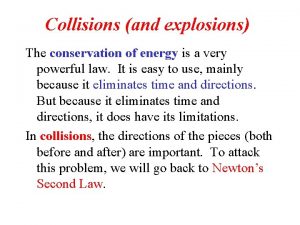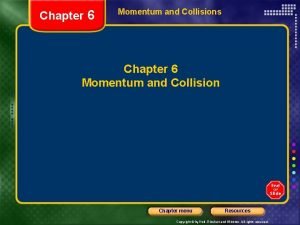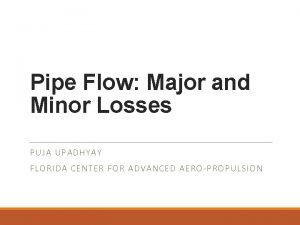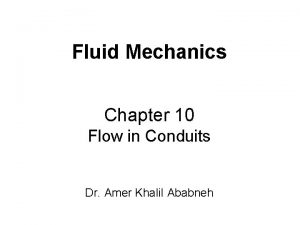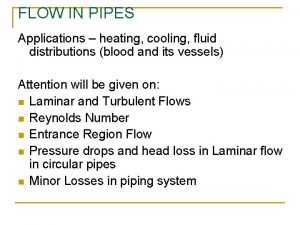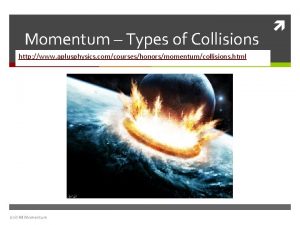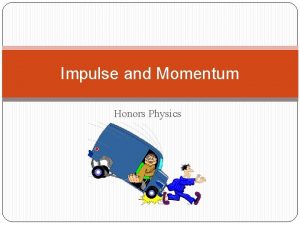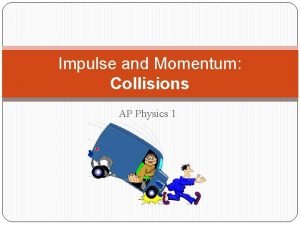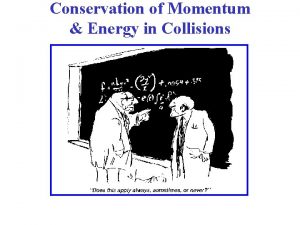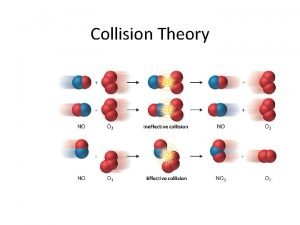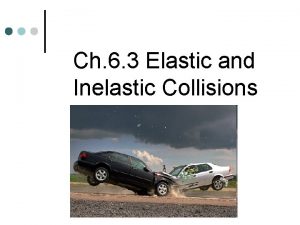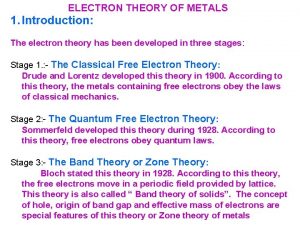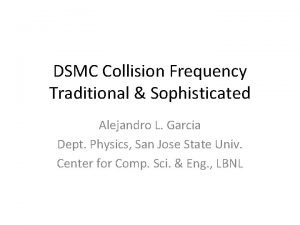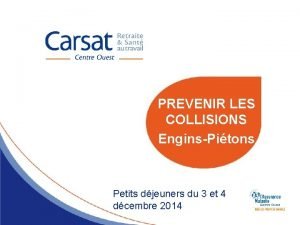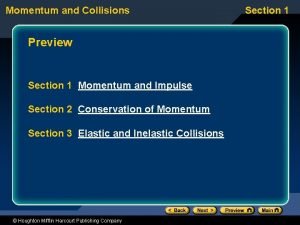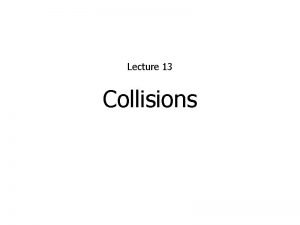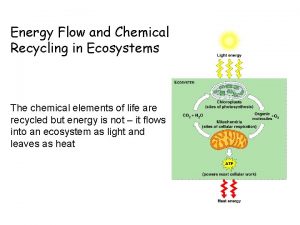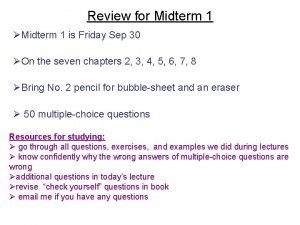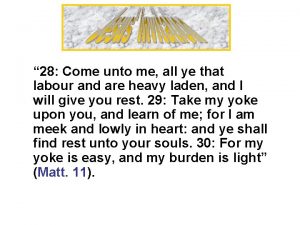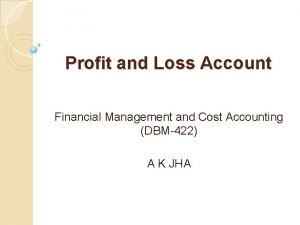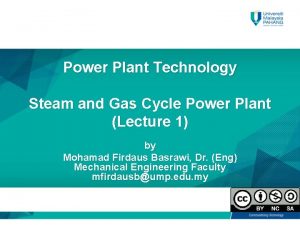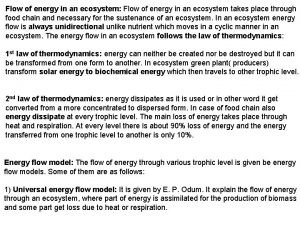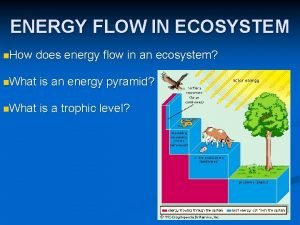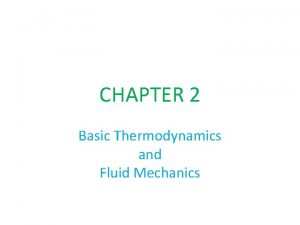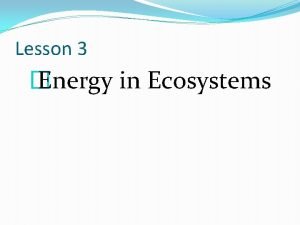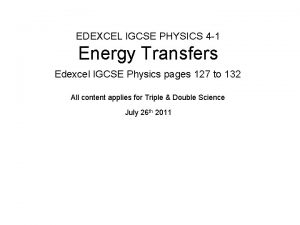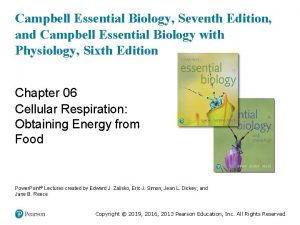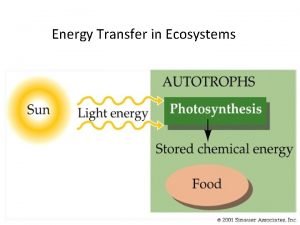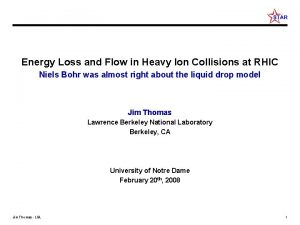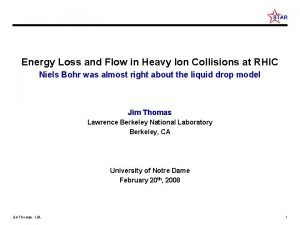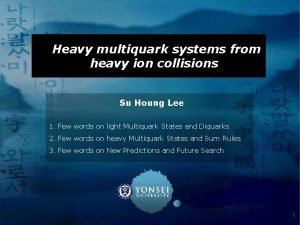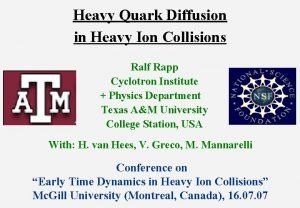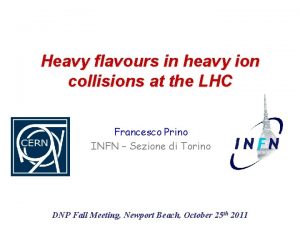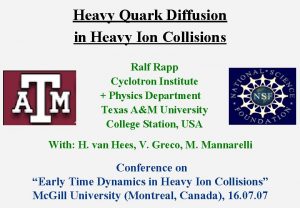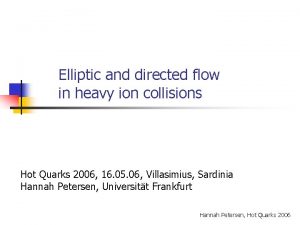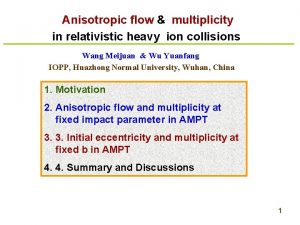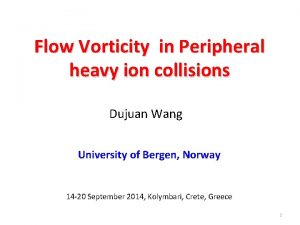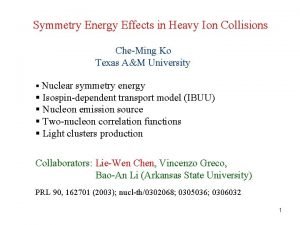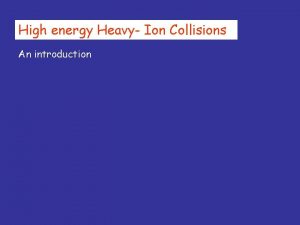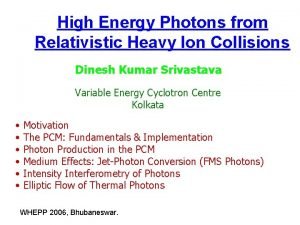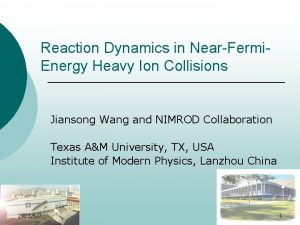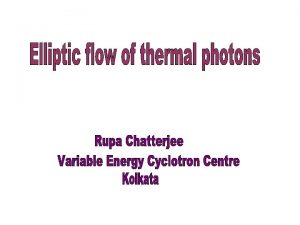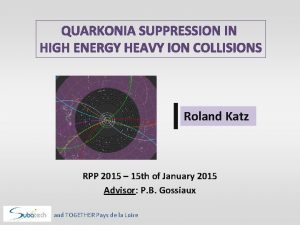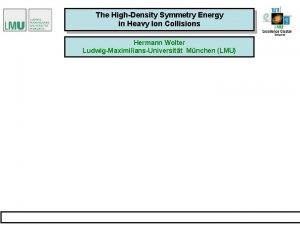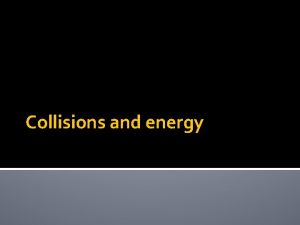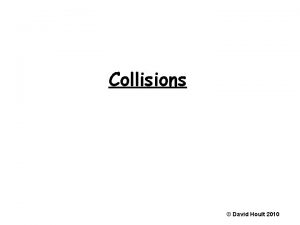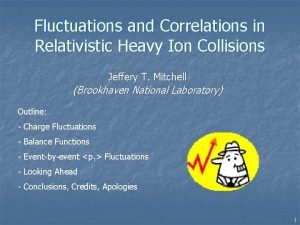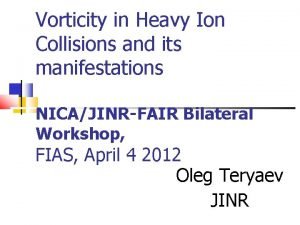Energy Loss and Flow in Heavy Ion Collisions









![STAR Tth [Ge. V] STAR Preliminary PHENIX < r> [c] Kinetic Freezeout from Transverse STAR Tth [Ge. V] STAR Preliminary PHENIX < r> [c] Kinetic Freezeout from Transverse](https://slidetodoc.com/presentation_image/59ad628d111d8a3d67134ddf92c76611/image-10.jpg)




























































































- Slides: 102

Energy Loss and Flow in Heavy Ion Collisions at RHIC Preparing to open a new chapter at RHIC with Charm + Beauty Jim Thomas Lawrence Berkeley National Laboratory Berkeley, CA Argonne National Laboratory March 5 th, 2008 Jim Thomas - LBL 1

Who is RHIC and What Does He Do? BRAHMS PHOBOS RHIC • Two independent rings • 3. 83 km in circumference PHENIX h • Accelerates everything, from p to Au s L p-p 500 1032 Au-Au 200 1027 (Ge. V and cm-2 s-1) • Polarized protons Lo Jim Thomas - LBL n sla g. I nd • Two Large and two small detectors were built And for a little while longer, it is the highest energy heavy ion collider in the world 2

STAR is a Suite of Detectors Time Projection Chamber Magnet Coils Silicon Tracker SVT & SSD TPC Endcap & MWPC FTPCs Beam Counters Endcap Calorimeter Central Trigger Barrel & TOF Barrel EM Calorimeter PMD Not Shown: p. VPDs, ZDCs, and FPDs 4. 2 meters A TPC lies at the heart of STAR Jim Thomas - LBL 3

RHIC Physics is Relativistic Nuclear Physics Jim Thomas - LBL 4

Unlike Particle Physics, the initial state is important • The nucleus is not a point like particle, it is macroscopic • Only a few of the nucleons participate in the collision as determined by the impact parameter • The initial state is Lorentz contracted • There is multiple scattering in the initial state before the hard collisions take place – Cronin effect • Cross-sections become coherent. – The uncertainty principle allows wee partons to interact with the front and back of the nucleus – The interaction rate for wee partons saturates ( ρσ = 1 ) • The intial state is even time dilated • Jimproton • neutron • delta • pion Thomas - LBL string – A color glass condensate 5

Au on Au Event at CM Energy ~ 130 Ge. V*A A Central Event Typically 1000 to 2000 tracks per event into the TPC Two-track separation 2. 5 cm Momentum Resolution < 2% Space point resolution ~ 500 m Rapidity coverage – 1. 8 < < 1. 8 Jim Thomas - LBL 6

Particle ID using Topology & Combinatorics Secondary vertex: Ks + p + + K e++e- Ks + + p + - dn/dm K++K + + from K+ K- pairs background subtracted m inv dn/dm K+ K- pairs same event dist. mixed event dist. m inv “kinks” K + Jim Thomas - LBL 7

Strange Baryons and Mesons: Au+Au @ 200 Ge. V , , and yields. vs. p. T Phys. Rev. Lett. 98 (2007) 060301 Jim Thomas - LBL 8

Transverse Radial Expansion: Isotropic Flow Au+Au at 200 Ge. V Ty pic - al S TA RD ata K- p T ≈ 215 Me. V T ≈ 310 Me. V T ≈ 575 Me. V Slopes decrease with mass. <p. T> and the effective temperature increase with mass. Jim Thomas - LBL The transverse radial expansion of the source (flow) adds kinetic energy to the particle distribution. So the classical expression for ETot suggests a linear relationship 9
![STAR Tth Ge V STAR Preliminary PHENIX r c Kinetic Freezeout from Transverse STAR Tth [Ge. V] STAR Preliminary PHENIX < r> [c] Kinetic Freezeout from Transverse](https://slidetodoc.com/presentation_image/59ad628d111d8a3d67134ddf92c76611/image-10.jpg)
STAR Tth [Ge. V] STAR Preliminary PHENIX < r> [c] Kinetic Freezeout from Transverse Radial Flow <ßr> (RHIC) = 0. 55 ± 0. 1 c TKFO (RHIC) = 100 ± 10 Me. V Thermal freeze-out determinations are done with the blast-wave model to find <p. T> Jim Thomas - LBL Explosive Transverse Expansion at RHIC High Pressure 10

Dependent Distributions – Flow • The overlap region in peripheral collisions is not symmetric in coordinate space • Almond shaped overlap region – Larger pressure gradient in the x-z plane drives flow in that direction – Easier for high p. T particles to emerge in the direction of x-z plane • Spatial anisotropy Momentum anisotropy • Perform a Fourier decomposition of the momentum -space particle distribution in the plane – For example, v 2 is the 2 nd harmonic Fourier coefficient of the distribution of particles with respect to the reaction plane Jim Thomas - LBL isotropic directed elliptic 11

Interpreting Flow – order by order n=1: Directed Flow has a period of 2 (only one maximum) – v 1 measures whether the flow goes to the left or right – whether the momentum goes with or against a billiard ball like bounce off the collision zone n=2: Elliptic flow has a period of (two maximums) – v 2 represents the elliptical shape of the momentum distribution isotropic Jim Thomas - LBL directed elliptic higher order terms 12

v 2 vs. p. T and Particle Mass • v 2 is large • The mass dependence is reproduced by hydrodynamic models – Hydro assumes local thermal equilibrium – At early times – Followed by hydrodynamic expansion PRL 86, 402 (2001) & nucl-ex/0107003 D. et al. , nucl-ex/0412001. QM 01 Proc. M. Teaney Oldenberg, P. P. Huovinenet etal. , nucl-th/0104020 QM 04 Anisotropic transverse flow is large at RHIC Jim Thomas - LBL – 6% in peripheral collisions (for pions average over all p. T ) • Flow is developed very rapidly – Data suggests very early times ~ fm/c • Hydro calculations are in good agreement with the data – Hydro assumes local thermal equilibrium – Followed by hydrodynamic expansion – The mass dependence is reproduced by the models 13

Elliptic Flow: in ultra-cold A Simulation ofan Elliptic Flow Fermi-Gas Li-atoms released from an optical trap exhibit elliptic flow analogous to what is observed in ultra-relativistic heavy-ion collisions – Elliptic flow is a general feature of strongly interacting systems! Jim Thomas - LBL 14

v 2 at high p. T shows meson / baryon differences Bulk PQCD Hydro Jim Thomas - LBL Asym. p. QCD Jet Quenching qn Coalescence 15

The Recombination Model ( Fries et al. PRL 90 (2003) 202303 ) The flow pattern in v 2(p. T) for hadrons is predicted to be simple if flow is developed at the quark level p. T → p. T /n v 2 → v 2 / n , n = (2, 3) for (meson, baryon) Jim Thomas - LBL 16

A Macroscopic many body system: It Flows Spatial anisotropy Momentum anisotropy – For example, v 2 is the 2 nd harmonic Fourier coefficient of the distribution of particles with respect to the reaction plane Jim Thomas - LBL isotropic directed elliptic 17

Elliptic flow scales with the number of quarks Implication: (uds) quarks, not hadrons, are the relevant degrees of freedom at early times in the collision history Jim Thomas - LBL 18

v 4 Exhibits Constituent Quark Scaling, too S. L. Huang QM 08 Jim Thomas - LBL isotropic directed elliptic higher order terms 19

Constituent Quark Scaling? • Hadrons are created by the recombination of quarks and this appears be the dominant mechanism for hadron formation at intermediate p. T • Baryons and Mesons are produced with equal abundance at intermediate p. T • The collective flow pattern of the hadrons appears to reflect the collective flow of the constituent quarks. • up, down, and strange quarks do it … despite the difference in their masses Partonic Collectivity Jim Thomas - LBL 20

Hints of Elliptic Flow with Charm Shingo Sakai, QM 2006 PRL 98, 172301 (2007) A Look to the Future: better if we can do direct topological identification of Charm Jim Thomas - LBL • D e +X Single electron spectra from PHENIX show hints of elliptic flow Is it charm or beauty? • Very profound, if it is true, because the Charm quark is rare and heavy compared to u, d, or s quarks • Indicator for rapid thermalization • Their will be RHIC upgrades to cut out large photonic backgrounds: e+eand reduce other large statistical and systematic uncertainties 21

Lets look at some collision systems in detail … Initial state Final state Au + Au d + Au p + p Jim Thomas - LBL 22

Partonic Energy Loss and Jet Quenching No quenching d+Au Quenching! Au+Au Energy loss suppression of leading hadron yield The jet can’t get out! Binary collision scaling Jim Thomas - LBL p+p reference 23

Heavy Flavor Energy Loss … RAA for Charm • Heavy Flavor energy loss is an unsolved problem Theory from Wicks et al. nucl-th/0512076 v 2 – Gluon density ~ 1000 expected from light quark data – Better agreement with the addition of inelastic E loss – Good agreement only if they ignore Beauty … • Beauty dominates single electron spectra above 5 Ge. V Where is the contribution from Beauty? Jim Thomas - LBL • In the future, RHIC upgrades will separate the Charm and Beauty contributions 24

Jet Physics … it is easier to find one in e+e. Jet event in e+e collision Jim Thomas - LBL STAR Au+Au collision 25

Angular Distribution: Peripheral Au+Au data vs. pp+flow Ansatz: A high p. T triggered Au+Au event is a superposition of a high p. T triggered p+p event plus anisotropic transverse flow v 2 from reaction plane analysis “A” is fit in non -jet region (0. 75<| |<2. 24) Jim Thomas - LBL 26

Angular Distribution: Jim Thomas - LBL Central Au+Au data vs. pp+flow 27

Lessons learned – Dark Matter … its opaque • The backward going jet is missing in central Au-Au collisions when compared to p-p data + flow • The backward going jet is not suppressed in d-Au collisions • These data suggest opaque nuclear matter and surface emission of jets Jim Thomas - LBL Surface emission Suppression of back-to-back correlations in central Au+Au collisions 28

Where does the Eloss go? PHENIX Away-side jet p+p Au+Au Trigger jet Lost energy of away-side jet is redistributed to rather large angles! Jim Thomas - LBL 29

Mach Cone: Theory vs Experiment STAR preliminary 0 -12% 200 Ge. V Au+Au mach cone near deflected jets near • Hint of a Mach Cone? Jim Thomas - LBL Medium away 30

The Ridge (after v 2 subtraction) d+Au Jet Au+Au Ridge 3 < p. T(trig) < 6 Ge. V 2 < p. T(assoc) < p. T(trig) Au+Au, 0 -5% d+Au, 40 -100% rel P R a min ry i A ST Jim Thomas - LBL 31

The Ridge May be due to Very Strong Fields Jim Thomas - LBL 32

Strong Fields Run Away Thermalisation Jim Thomas - LBL 33

Ad. S/CFT correspondence (from H. Liu) Maldacena (1997) Gubser, Klebanov, Polyakov, Witten N = 4 Super-Yang-Mills theory with SU(N) A string theory in 5 -dimensional anti-de Sitter spacetime anti-de Sitter (Ad. S) spacetime: homogeneous spacetime with a negative cosmological constant. N = 4 Super-Yang-Mills (SYM): maximally supersymmetric gauge theory scale invariant A special relative of QCD The value turns out to be universal for all strongly coupled QGPs with a gravity description. It is a universal lower bound. Jim Thomas - LBL 34

PHENIX PRL 98, 172301 (2007) • RAA of heavy-flavor electrons in 0%– 10% central collisions compared with 0 data and model calculations 0 • V 2 of heavy-flavor electrons in minimum bias collisions compared with 0 data and the same models. • Conclusion is that heavy flavor flow corresponds to /s at the conjectured QM lower bound Jim Thomas - LBL 35

Old Chinese Proverb Beware of theorists waiting for data – Confusion Jim Thomas - LBL 36

Nuclear Fluid Dynamics. . . with friction • The energy momentum tensor for a viscous fluid • Conservation laws: and where • The elements of the shear tensor, , describe the viscosity of the fluid and can be thought of as velocity dependent ‘friction’ • Simplest case: scaling hydrodynamics – – – assume local thermal equilibrium assume longitudinal boost-invariance cylindrically symmetric transverse expansion no pressure between rapidity slices conserved charge in each slice • Initially expansion is along the Z axis, so viscosity resists it – Conservation of T means that energy and momentum appear in the transverse plane … viscosity drives radial flow • Viscosity is velocity dependent friction so it dampens v 2 – Viscosity ( /z ) must be near zero for large elliptic flow to be observed Jim Thomas - LBL 37

3 D Hydro … new insights • Romatschke 2 performed relativistic viscous hydrodynamics calculations including the new 2 nd order terms beyond Landau’s prescription • Data on the integrated elliptic flow coefficient v 2 are consistent with a ratio of viscosity over entropy density up to /s 0. 16 PRL 99, 172301 (2007) Jim Thomas - LBL • But data on minimum bias v 2 seem to favor a much smaller viscosity over entropy ratio, below the bound from the anti –de Sitter conformal field theory conjecture 38

Which theory is correct? Only the data can tell. Jim Thomas - LBL 39

Viscosity and the Perfect Fluid H 2 O N 2 He hadronic partonic The universal tendency of flow to be dissipated due to the fluid’s internal friction results from a quantity known as the shear viscosity. All fluids have non-zero viscosity. The larger the viscosity, the more rapidly small disturbances are damped away. Quantum limit: /s. Ad. S/CFT ~ 1/4 p. QCD limit: ~ 1 At RHIC: ideal ( /s = 0) hydrodynamic model calculations fit to data Caption: The viscosity to entropy ratio versus a reduced temperature. Perfect Fluid at RHIC? ! Lacey et al. PRL 98: 092301(07) hep-lat/0406009; hep-ph/0604138 Csernai et al, PRL 97, 152303(06) Jim Thomas - LBL 40

STAR Upgrades to keep the discoveries rolling … In the queue • Forward Meson Spectrometer – Gluon density distributions, saturation effects, and transverse spin • DAQ Upgrade – order of magnitude increase in rate – extra bandwidth opens the door to ‘small’ physics • Full Barrel MRPC TOF Engines running – extended particle identification at intermediate p. T • Forward GEM Tracker – end cap tracker for W sign determination • Heavy Flavor Tracker – high precision Heavy Flavor Tracker near the vertex Warming Up – opens the door to direct topological ID of Charm & Beauty Jim Thomas - LBL • • Muon Telescope Forward Reaction Plane Detector A Crystal Calorimeter for low E photons - HBT 41

Opening New Frontiers at RHIC • (Hint … Segue to new hardware) • Direct topological reconstruction of open charm (explain why) • The prevailing hypothesis is that we have partonic collectivity at RHIC • Is there collective behavior in the charm sector, too? – If so, it would be extraordinary because charm is so heavy • Beauty is accessible but difficult • What is the challenge … with the hardware Jim Thomas - LBL 42

The Properties of the Open Charm Hadrons Particle D 0 D+ Decay Channel c ( m) Mass (Ge. V/c 2) (3. 8%) 123 1. 8645 K + + (9. 5%) 312 1. 8694 150 1. 9683 59. 9 2. 2865 K + K+ K + (5. 2%) + + - (1. 2%) p K + (5. 0%) Jim Thomas - LBL 43

Direct Topological Identification of Open Charm Goal: Distinguish secondary from primary vertices by putting a high precision detector near the IP to extend the TPC tracks to small radius The STAR Inner Tracking Upgrades will identify the daughters in the decay and do a direct topological reconstruction of the open charm hadrons. 50 -150 m No ambiguities between charm and beauty. Jim Thomas - LBL 44

The Heavy Flavor Tracker = PXL + IST + SSD PXL: 2 layers of Si at small radii IST: 1 layer of Si at intermediate radius SSD: an existing detector at 23 cm radius Jim Thomas - LBL • A new detector – 30 m silicon pixels to yield 10 m space point resolution • Direct Topological reconstruction of Charm – Detect charm decays with small c , including D 0 K • New physics – Charm collectivity and flow to test thermalization at RHIC – Charm Energy Loss to test p. QCD in a hot and dense medium at RHIC • The SSD … is part of the plan for tracking TPC HFT • The technical design is evolving but converging rapidly to final form. 45

Active Pixel Sensors from IPHC Strasbourg • • • 30 m pixels 640 x 640 pixels per chip 10 chips per ladder 100 – 200 sec integration time 164 M pixels, total 300 k. Rad hardness 20 cm (~1 yr under certain conditions) Inner layer Properties: Outer layer • Signal created in low-doped epitaxial layer (typically ~10 -15 μm) • Sensor and signal processing integrated in the same silicon wafer • Standard commercial CMOS technology Jim Thomas - LBL 46

Getting a Boost from the TPC • The TPC provides good but not excellent resolution at the vertex and at other intermediate radii OFC ~ 1 mm • The TPC provides an excellent angular constraint on the path of a predicted track segment TPC – This is very powerful. – It gives a parallel beam with the addition of MCS from the IFC • The best thing we can do is to put a pin-hole in front of the parallel beam track from the TPC IFC – This is the goal for the Si trackers: SSD, IST, and PXL • The SSD and IST do not need extreme resolution. Instead, the goal is to maintain the parallel beam and not let it spread out – MCS limited – The PXL does the rest of the work Jim Thomas - LBL MCS Cone VTX The Gift of the TPC 47

Optimized HFT Configuration The HFT configuration described in the Addendum Jim Thomas - LBL 48

Calculating the Performance of the Detector • Billoir invented a matrix method for evaluating the performance of a detector system including MCS and d. E/dx – NIM 225 (1984) 352. • The ‘Information Matrices’ used by Billoir are the inverse of the more commonly used covariance matrices – thus, ’s are propagated through the system • ITTF tracking software uses a similar method (aka a Kalman Filter) – The ‘hand calculations’ go outside-in – STAR Software goes outside-in and then inside-out, and averages the results, plus follows trees of candidate tracks. It is ‘smart’ software. Jim Thomas - LBL 49

Hand Calculations. vs. GEANT & ITTF TPC alone Full System - - PXL stand alone configuration Paper Proposal configuration GEANT & ITTF Updated configuration … no significant changes in pointing at VTX Jim Thomas - LBL 50

Min. Bias Pileup – The PXL Layers Integrate over Time Integrate over time and interaction diamond 200 sec Radius Central collision hit density Integrated Min. Bias collisions (pileup) UPC electrons Totals PIXEL-1 Inner Layer 2. 5 cm 17. 8 cm-2 23. 5 cm-2 19. 9 cm-2 61. 2 cm-2 PIXEL-2 Outer Layer 8. 0 cm 1. 7 cm-2 4. 2 cm-2 0. 1 cm-2 6. 0 cm-2 Pileup is the bigger challenge A full study of the integrated hit loading on the PIXEL detector includes the associated pileup due to min. Bias Au-Au collisions and the integration time of the detector. Jim Thomas - LBL 51

Efficiency Calculations in a high hit density environment The probability of associating the right hit with the right track on the first pass through the reconstruction code is: P(good association) = 1 / (1+S) where S = 2 x y P(bad association) = (1 – Efficiency) = S / ( 1 + S ) and when S is small P(bad association) 2 x y An area A density, depends on and pileup x is the convolution of the detector resolution and the projected track error in the ‘x’ direction, and is the density of hits. The largest errors dominates the sum x = ( 2 xp + 2 xd ) y = ( 2 yp + 2 yd ) Asymmetric pointing resolutions are very inefficient … try to avoid it Jim Thomas - LBL 52

The performance of the TPC pointing at the PXL • The performance of the TPC acting alone to point at the PXL detector depends on the integration time of the PXL chips P(good association) = 1 / (1+S) where S = 2 x y depends on Single Layer Efficiency 1 0. 9 0. 8 0. 7 2. 5 cm 0. 6 0. 5 0. 4 PXL-1 PXL-2 0. 3 0. 2 0. 1 8. 0 cm 0 1 10 10000 Integration Time ( sec) The purpose of intermediate tracking layers is to make 55% go up to ~100% Jim Thomas - LBL 53

The performance of the TPC + SSD + PXL • The performance of the TPC + HFT acting together depends on the integration time of the PXL chip … but overall the performance is very good P(good association) = 1 / (1+S) where S = 2 x y Single Layer Efficiency 1 0. 9 Note that systematic errors are not included in the hand calculations nor in the GEANT Simulations 0. 8 0. 7 0. 6 0. 5 0. 4 0. 3 SSD PXL-2 PXL-1 0. 2 0. 1 0 1 10 10000 Integration Time ( sec) Random errors only included in hand calculations and in GEANT/ITTF simulations Jim Thomas - LBL 54

The performance of the TPC + SSD + IST + PXL – Goal: graded resolution and high efficiency from the outside in – TPC – SSD – IST – PXL – TPC pointing resolution at the SSD ~ 1 mm = 0. 98 – SSD pointing at the IST is ~ 400 m = 0. 98 – IST pointing at PXL 2 is ~ 400 m = 0. 93 – PXL 2 pointing at PXL 1 is ~ 125 m = 0. 94 – PXL 1 pointing at the VTX is ~ 40 m ~ 50 cm Raw HFT Tracking Efficiency: Jim Thomas - LBL 0. 98 x 0. 93 x 0. 94 = 0. 84 The challenge is to find tracks in a high density environment Geometric acceptance and TPC track finding efficiencies 0 needs with high efficiency because a. D single track 2 0. 9 x 0. 8 = 0. 65 In this example Tot = 0. 55 55

D 0 reconstruction MD 0 = 1. 8645 Ge. V/c 2 c = 123 m V 0(D 0) dca K 0. 5 < p. T < 1. 5 Ge. V/c Jim Thomas - LBL 56

D 0 expected invariant mass distributions p. T For 100 M Au+Au central collisions at 1 x RHIC II luminosity p. T distributions for (S, B) at high p. T are from power-law guess and Hijing, respectively. D 0 Background slope at high p. T could be uncertain due to limited statistics in MC. Jim Thomas - LBL 57

D 0 Reconstruction Efficiency Geant/ITTF • The predicted absolute efficiency of the HFT detector. – The red squares show the efficiency for finding the D 0 meson with the full set of Geant/ITTF techniques. The black circles show the efficiency AFTER cuts. • The tracking efficiency is improved by 20 -30% compared to the simulation in the proposal. Mostly due to improved hit selection in PXL. Jim Thomas - LBL 58

Improved understanding of signal / background 100 M Au+Au central @ 200 Ge. V _ | | < 1, D 0+D 0 Updated: S: D 0 yield d. N/dy = 2 Loosen the # of PIXEL hits selection D 0 background in more real estimation Assume perfect PID at p. T<1. 5 Ge. V and no PID at p. T>1. 5 Ge. V/c Jim Thomas - LBL 59

Estimate v 2 sensitivity – focus on the error bars From central to minimum bias, assume: D 0 scaled by Nbin Hijing background scaled by Npart Jim Thomas - LBL 60

Estimate Rcp sensitivity: focus on the error bars Jim Thomas - LBL 61

The next level of difficulty: Charm baryon - c M = 2. 286 Ge. V/c 2 c = 60 m p. T Jim Thomas - LBL 62

Nuclear Matter at RHIC … a perfect liquid … an s. QGP • Its hot – Chemical freeze out at 175 Me. V & Thermal freeze out at 100 Me. V • Its fast – Transverse expansion with an average velocity greater than 0. 55 c – Large amounts of anisotropic flow (v 2) suggest hydrodynamic expansion and high pressure at early times in the collision history • Its opaque and strongly interacting – Saturation of v 2 at high p. T – RAA … suppression of high p. T particle yields relative to p-p – Jet Quenching … suppression of the away side jet • It has partonic degrees of freedom – Constituent quark scaling of v 2 and v 4 for u, d, s and perhaps charm • There are hints that it is thermally equilibrated – Excellent fits to particle ratio data with equilibrium thermal models • And it has nearly zero viscosity and perhaps a Mach cone – Perhaps it is at or below the quantum bound from the Ad. S/CFT conjecture Jim Thomas - LBL 63

Backup Slides Jim Thomas - LBL 64

TPC Pointing at the PXL Detector • The TPC pointing resolution on the outer surface of the PXL Detector is greater than 1 mm … but lets calculate what the TPC can do alone – Assume the new radial location at 8. 0 cm for PXL-2, with 9 m detector resolution in each pixel layer and a 200 sec detector Radius Point. Res. On (R- ) (Z) Hit Density (cm-2) 8. 0 cm 1. 4 mm 1. 5 mm 6. 0 2. 5 cm 90 m 110 m 61. 5 – Notice that the pointing resolution on PXL-1 is very good even though the TPC pointing resolution on PXL-2 is not so good • The probability of a good hit association on the first pass – 55% on PXL 2 – 95% on PXL 1 The purpose of the intermediate tracking layers is to make 55% go up to ~100% All values quoted for mid-rapidity Kaons at 750 Me. V/c This is surprising: The hard work gets done at 8 cm! Jim Thomas - LBL 65

PT of the Pion (Ge. V/c) D 0 Decay Kinematics PT of the Kaon (Ge. V/c) • D 0’s thrown by Pythia for p-p collisions • D 0 p. T shown by different color dots (e. g. Blue = 1. 3 Ge. V D 0 s) Jim Thomas - LBL 66

• p. T distributions of electrons from semi-leptonic decay of heavy flavor mesons (left D-mesons, right B-mesons) as a function of parent p. T. The inserted plots represent the projections to the corresponding heavy flavor distributions. The widths of the electron p. T windows are indicated by dashed boxes. Jim Thomas - LBL 67

3<pt, trigger<4 Ge. V pt, assoc. >2 Ge. V Au+Au 0 -10% preliminary Jim Thomas - LBL 68

The Development of a Weibal Instability Jim Thomas - LBL 69

Nomenclature: Rapidity vs xf • xf = pz / pmax – A natural variable to describe physics at forward scattering angles • Rapidity is different. It is a measure of velocity but it stretches the region around v = c to avoid the relativistic scrunch β – Rapidity is relativistically invariant and cross-sections are invariant Rapidity and p. T are the natural kinematic variable for HI collisions ( y is approximately the lab angle … where y = 0 at 90 degrees ) When the mass of the particle is unknown, then y Jim Thomas - LBL 70

V 1: Pions go opposite to Neutrons 62 Ge. V Data At low energy, the pions go in the opposite direction to the ‘classical’ bounce of the spectator baryons 200 Ge. V Data At the top RHIC energy, the pions don’t flow (v 1 at =0 ) but at ALICE, v 1 may have a backward wiggle. Reveals the EOS Jim Thomas - LBL • hi 71

Interpreting Flow – order by order n=1: Directed Flow has a period of 2 (only one maximum) – v 1 measures whether the flow goes to the left or right – whether the momentum goes with or against a billiard ball like bounce off the collision zone n=2: Elliptic flow has a period of (two maximums) – v 2 represents the elliptical shape of the momentum distribution isotropic Jim Thomas - LBL directed elliptic 72

TPC Gas Volume & Electrostatic Field Cage 420 CM • Gas: P 10 ( Ar-CH 4 90%-10% ) @ 1 atm • Voltage : - 28 k. V at the central membrane Jim Thomas - LBL 135 V/cm over 210 cm drift path Self supporting Inner Field Cage: Al on Kapton using Nomex honeycomb; 0. 5% rad length 73

Bjorken Estimate of Initial Energy Density Boost invariant hydrodynamics: Bjorken Estimate of Initial Energy Density ~ 6. 5 fm Cold nuclear matter: r 0 ~ 0. 16 Ge. V/fm 3 t ~ 0. 2 - 1 fm/c time to thermalize the system 30 xr 0 R 2 nucl-ex/0311017 PRL 87 (01) 52301 Jim Thomas - LBL 74

QCD is a Rich Theory with Many Features We have a theory of the strong interaction Hadron “level” Diagram Low(er) energy nuclear physics uses OPEP or descriptions in terms of a pion gas. These worked because QCD is a theory with a mass gap. This gap is a manifestation of the approximate SU(2)R x SU(2)L chiral symmetry of QCD with pions as the Nambu-Goldstone bosons Jim Thomas - LBL { W. Zajc 75

Something Funny Happens at T > m c 2 An exponentially increasing density of hadronic states suggests – A “limiting temperature” TH – A phase transition(? ) in hadronic matter This was noticed before quarks were identified as the constituents of matter – ( Hagedorn, Nuovo Cimento Supp. , 3 (147) 1965 ) Density of States. vs. Energy Fit this form with TH = 163 Me. V Thermal equilibrium suggests Which requires T < TH Jim Thomas - LBL 76

Charm Cross Sections at RHIC 1) Large systematic uncertainties in the measurements 2) Theory under predict by a factor ~ 2 and STAR ~ 2 x PHENIX 3) Directly reconstructed charm hadrons Upgrades Jim Thomas - LBL 77

Au on Au Event at CM Energy ~ 130 Ge. V*A Data taken June 25, 2000. The first 12 events were captured on tape! Real-time track reconstruction Pictures from Level 3 online display. ( < 70 m. Sec ) Jim Thomas - LBL 78

Identified Mesons and Baryons: Au+Au @ 200 Ge. V and p yields. vs. p. T Jim Thomas - LBL Phys. Rev. Lett. 97 (2006) 152301 79

The Large Detectors – PHENIX and STAR Jim Thomas - LBL PHENIX 80

Partonic energy loss via leading hadrons Energy loss softening of fragmentation suppression of leading hadron yield Binary collision scaling Jim Thomas - LBL p+p reference 81

Au+Au and p+p: inclusive charged hadrons PRL 89, 202301 p+p reference spectrum measured at RHIC Jim Thomas - LBL 82

PHENIX data on the suppression of 0 s lower energy Pb+Pb lower energy a+a Factor ~5 suppression for central Au+Au collisions Jim Thomas - LBL 83

Pixel & IST – optimizations and progress End view 8 cm radius ALICE style carbon support beams (green) 2. 5 cm radius Inner layer See talks by Outer layer HH Wieman B Surrow • One IST layer at 14 cm • Good performance • Utilizes the existing SSD • Fewer channels • Lower cost • Extra space for PXL layers • Basic Parameters – Short strips ( < 1 cm ) – Wide strips ( ~ 500 m ) – Approx 150 m x 2000 m resolution Jim Thomas - LBL The proposed changes and optimizations have been verified with hand calculations and are scheduled to be put thru a full system test with GEANT/ITTF simulations. 84

Central Collisions: Density of hits on the Detectors where 100, 000 pixels cm-2 Au+Au Luminosity (RHIC-II) dn/d (Central) dn/d (Min. Bias) Min. Bias cross section Min. Bias collision rate (RHIC-II) Interaction diamond size, σ Integration time for Pixel Chips Radius PXL 1 PXL 2 IST SSD 2. 5 cm 8. 0 cm 14. 0 cm 23. 0 cm 80 x 1026 cm-2 s-1 700 170 10 barns 80 k. Hz 15 cm 200 sec Simple Formulas 17. 8 cm-2 1. 7 cm-2 0. 57 cm-2 0. 21 cm-2 Slightly conservativ e numbers HIJING thru GEANT 19. 0 cm-2 1. 8 cm-2 0. 66 cm-2 0. 23 cm-2 The density of hits is not large compared to the number of pixels on each layer. The challenge, instead, is for tracking to find the good hits in this dense environment. Jim Thomas - LBL 85

Monte Carlo Simulation Strategy & Updates Central Au. Au events from Hijing PIXEL hits pileup Detector response simulation Geometry definition in GEANT Digitization to raw hits Real data from DAQ STAR ITTF reconstructi on chain User's analysis code Association between rec and MC D 0 Measurements: d. N/dy per NN collision ~ 0. 004 (STAR) we take half of this as our estimate of the rate # Hits selection in PIXEL: MC hits and Rec hits can be > 2 we include these tracks D 0 Background: K from D decays and from other decays -- important at high p. T. D 0 -> K- + X (53%) PID with TOF: Assume perfect K/ at p. T< 1. 5 Ge. V/c, no PID for K/ beyond that. Background also includes PID contamination. Jim Thomas - LBL 86

Geometry definition in MC and event sample Hit position in silicon layers from MC Segment sizes and resolutions 9 x 9 Central (b = 0 -3 fm) Au-Au Hijing + 10 D 0 per event (flat p. T, eta) |Vertex_z| < 5 cm BR=100% Jim Thomas - LBL 87

D 0 S, B evolution with different pileup levels Jim Thomas - LBL 88

Pixel Prototype – Geant. vs. Hand Calculations GEANT acceptance) Acceptance (for D 0 s thrown into the TPC Hand Calculations p. T of the D 0 (Ge. V/c) p. T of the D 0 (Me. V/c) • Three arm PXL prototype configuration (early deployment / engineering test) • Good acceptance around the expected mean p. T of D 0 ’s (i. e. ~1 Ge. V) • Ideal to measure charm cross-section via direct topological reconstruction Jim Thomas - LBL 89

The Simplest ‘Simulation’ – basic performance check • Study the last two layers of the system with basic telescope equations with MCS – PXL 1 and PXL 2 alone ( no beam pipe ) – Give them 9 m resolution TPC alone PXL alone • In the critical region for Kaons from D 0 decay, 750 Me. V to 1 Ge. V, the PXL single track pointing resolution is predicted to be 20 -30 m … which is sufficient to pick out a D 0 with c = 123 m • The system (and especially the PXL detector) is operating at the MCS limit In- LBL principle, the full detector can be analyzed 2 layers at a time … Jim • Thomas hh 90

HFT Performance & Simulation Studies A marriage of Intuition, Hand Calculations, and Detailed Geant Simulations Jim Thomas Lawrence Berkeley National Laboratory February 25 -26, 2008 Jim Thomas - LBL 91

Graded Resolution from the Outside In TPC SSD TPC vtx SSD IST PXL 2 PXL 1 VTX PXL alone • A PXL detector requires external tracking to be a success – The TPC and intermediate tracking provide graded resolution from the outside-in • The intermediate layers form the elements of a ‘hit finder’ – The spatial resolution is provided by the PXL layers Jim Thomas - LBL • The next step is to ensure that the hit finding can be done efficiently at every layer in a high hit density environment 92

Ghosting increases as pileup increases Pile-up level: 1 x RHIC II luminosity Jim Thomas - LBL 93

Secondary Vertex Resolution Counts c cm Jim Thomas - LBL cm Left figure, observed decay length (including realistic p. T weighting) Right figure, D 0 decay length scaled by a factor of 1/ No beamline constraint required … In central Au. Au collisions, the D 0 secondary vertices are clearly separated from the primary vertex 94

The Phase Diagram for Nuclear Matter The goal is to explore nuclear matter under extreme conditions – T > m c 2 , > 10 * 0 and net 0 Jim Thomas - LBL • The goal at RHIC is to understand the QCD in the context of the many body problem • Another goal is to discover and characterize the Quark Gluon Plasma • RHIC is a place where fundamental theory and experiment can meet after many years of being apart 95

Kinetic freeze-out time Chemical and Kinetic Freeze-out Chemical freeze-out elastic interactions inelastic interactions blue beam • Chemical freeze-out (first) – End of inelastic interactions – Number of each particle species is frozen • Useful data – Particle ratios Jim Thomas - LBL yellow beam • space Kinetic freeze-out (later) – End of elastic interactions – Particle momenta are frozen • Useful data – Transverse momentum distributions – and Effective temperatures 96

Chemical Freeze-out – from a thermal model Thermal model fits Compare to QCD on the (old) Lattice: Tc = 154 ± 8 Me. V (Nf=3) Tc = 173 ± 8 Me. V (Nf=2) (ref. Karsch, various) • The model assumes a thermally and chemically equilibrated fireball at hadro-chemical freeze-out which is described by a temperature T and (baryon) chemical potential : dn ~ e-(E- )/T d 3 p • Works great, but there is not a word of QCD in the analysis. Done entirely in a color neutral Hadronic basis! input: measured particle ratios output: temperature T and baryo-chemical potential B Jim Thomas - LBL 97

Putting RHIC on the Phase Diagram • Final-state analysis suggests RHIC reaches the phase boundary • Hadron spectra cannot probe higher temperatures • Hadron resonance ideal gas (M. Kaneta and N. Xu, Lattice results nucl-ex/0104021 & QM 02) – TCH = 175 ± 10 Me. V – B = 40 ± 10 Me. V Neutron STAR • <E>/N ~ 1 Ge. V (J. Cleymans and K. Redlich, PRL 81, p. 5284, 1998 ) We know where we are on the phase diagram but eventually we want to know what other features are on the diagram Jim Thomas - LBL 98

-meson Flow: Partonic Flow -mesons are special: - they show strong collective flow and - they are formed by coalescence of thermalized s-quarks ‘They are made via coalescence of seemingly thermalized quarks in central Au+Au collisions, the observations imply hot and dense matter with partonic collectivity has been formed at RHIC’ Phys. Rev. Lett. 99 (2007) 112301 and Phys. Lett. B 612 (2005) 81 Jim Thomas - LBL 99

The Suppression occurs in Au-Au but not d-Au No quenching d+Au Quenching! Au+Au Jim Thomas - LBL 100

Single Track Efficiencies & Ghosting Hand Calculations Ghost Rate = 1 – Raw Tracking Efficiency Hand calculations assume the acceptance is flat in p. T and assume a single track at = 0. 5 Au + Au central collisions @ 200 Ge. V TPC tracking efficiency ~80 -85% Ghosting = # of tracks with 2 PIXEL hits & either of 2 PIXEL hits is a wrong hit # of track with 2 PIXEL hits Jim Thomas - LBL 101

Summary: A rich physics program with the HFT • The HFT is thin, unique, innovative and robust • The design have been tested extensively with hand calculations and a few key examples have been simulated with GEANT/ITTF software • Simulations … completed tasks A full Monte Carlo simulation + reconstruction chain with HFT in STAR Comprehensive study on the pointing resolution and single track efficiency for the STAR system with HFT with full MC simulations. Comprehensive study on the D 0 reconstruction in Au+Au central collisions, including realistic signal/background study. D 0 reconstruction efficiency in Au+Au Quantify the pile-up effect on the single track efficiency (ghosting), D 0 background and signal significance. • To do Improved understanding of single track efficiency and ghosting at low p T Optimization of D 0 reconstruction at low p. T – improving efficiency Systematic study of other Charm hadrons, such as the c, and Bottom p+p 200/500 Ge. V simulations, pile-up effect and improved vertex finders Jim Thomas - LBL 102
 Elastic and inelastic collisions examples
Elastic and inelastic collisions examples Ratey rational functions
Ratey rational functions Heavy ion
Heavy ion Scrap account
Scrap account Ion dipolo
Ion dipolo Fuerzas dipolo dipolo ejemplos
Fuerzas dipolo dipolo ejemplos Que son fuerzas intramoleculares
Que son fuerzas intramoleculares Induced dipole
Induced dipole Energy naturally flows from warmer matter to cooler matter
Energy naturally flows from warmer matter to cooler matter Oikos meaning
Oikos meaning How to calculate cash flow from profit and loss statement
How to calculate cash flow from profit and loss statement Elastic vs inelastic
Elastic vs inelastic Type of momentum
Type of momentum A roller coaster climbs up a hill at 4m/s and then
A roller coaster climbs up a hill at 4m/s and then Inelastic collision
Inelastic collision Collisions and explosions
Collisions and explosions Collisions
Collisions Chapter 6 momentum
Chapter 6 momentum Energy energy transfer and general energy analysis
Energy energy transfer and general energy analysis Energy energy transfer and general energy analysis
Energy energy transfer and general energy analysis Critical reynolds number
Critical reynolds number Head loss equation
Head loss equation Head loss formula for turbulent flow
Head loss formula for turbulent flow Aplusphysics momentum-impulse answer key
Aplusphysics momentum-impulse answer key Types of collsions
Types of collsions Ap physics collisions
Ap physics collisions To avoid collisions a defensive driver should
To avoid collisions a defensive driver should How do we know momentum is conserved
How do we know momentum is conserved Which is/are necessary for successful collisions to occur
Which is/are necessary for successful collisions to occur Inelastic collision examples real world
Inelastic collision examples real world Difference between elastic and inelastic collision
Difference between elastic and inelastic collision Momentum is conserved in all collisions
Momentum is conserved in all collisions When you move into the deceleration lane, you should
When you move into the deceleration lane, you should Drawbacks of free electron theory
Drawbacks of free electron theory Collisions
Collisions To avoid collisions a defensive driver should
To avoid collisions a defensive driver should Prévention des collisions engins-piétons
Prévention des collisions engins-piétons Collisions
Collisions Elastic energy
Elastic energy Loss of kinetic energy in inelastic collision
Loss of kinetic energy in inelastic collision Transform flow and transaction flow in software engineering
Transform flow and transaction flow in software engineering Data flow structure
Data flow structure Differentiate between rotational and irrotational flow
Differentiate between rotational and irrotational flow Internal and external flow
Internal and external flow Control flow and data flow computers
Control flow and data flow computers Define turbulent flow
Define turbulent flow What is feeding relationship
What is feeding relationship Motive force
Motive force Energy flow and material cycling in ecosystem
Energy flow and material cycling in ecosystem Agroecosystem concept
Agroecosystem concept Magic box respiratory
Magic box respiratory 15l to fio2
15l to fio2 T piece ventilation
T piece ventilation Internal and external flow
Internal and external flow Data flow vs control flow
Data flow vs control flow Cheese processing flow chart
Cheese processing flow chart Transaction flow graph
Transaction flow graph A large heavy truck and a small baby carriage
A large heavy truck and a small baby carriage Come unto me all who are weak weary and heavy laden lyrics
Come unto me all who are weak weary and heavy laden lyrics For the two processes shown which of the following is true
For the two processes shown which of the following is true Adjective comparative superlative heavy
Adjective comparative superlative heavy Come unto me oh ye that labour
Come unto me oh ye that labour Heavy lift and transport lake charles
Heavy lift and transport lake charles Trading and profit and loss account vertical format
Trading and profit and loss account vertical format Allocation of expenses in departmental accounting
Allocation of expenses in departmental accounting Errors that affect the trial balance
Errors that affect the trial balance Explain profit and loss account
Explain profit and loss account Chemical potential energy images
Chemical potential energy images Primary energy and secondary energy
Primary energy and secondary energy Hypdro
Hypdro Helmholtz free energy and gibbs free energy
Helmholtz free energy and gibbs free energy Renewable energy and energy efficiency partnership
Renewable energy and energy efficiency partnership Potential energy meaning
Potential energy meaning Mechanical energy conservation
Mechanical energy conservation Potential energy
Potential energy Formula of potential energy
Formula of potential energy Energy forms and energy conversions
Energy forms and energy conversions How does heat energy flow
How does heat energy flow Energy balance equation thermodynamics open system
Energy balance equation thermodynamics open system Steam cycle
Steam cycle Chapter 4 lesson 2 energy flow in ecosystems answer key
Chapter 4 lesson 2 energy flow in ecosystems answer key Dandelion food chain
Dandelion food chain Y shaped energy flow model
Y shaped energy flow model How does energy flow through the ecosystem
How does energy flow through the ecosystem Flow of energy definition
Flow of energy definition Pyramid of energy flow
Pyramid of energy flow How does energy flow in a food web
How does energy flow in a food web Section 2 flow of energy in an ecosystem
Section 2 flow of energy in an ecosystem Steady flow energy equation
Steady flow energy equation Atp and adp cycle
Atp and adp cycle Regents biology food chains and energy in ecosystems
Regents biology food chains and energy in ecosystems Grade 7 term 3 natural science test
Grade 7 term 3 natural science test Chapter 4 lesson 2 energy flow in ecosystems answer key
Chapter 4 lesson 2 energy flow in ecosystems answer key Are tertiary consumers apex predators
Are tertiary consumers apex predators What is energy flow in a food chain
What is energy flow in a food chain Light bulb energy transfer diagram
Light bulb energy transfer diagram Inputs of glycolysis
Inputs of glycolysis Consumer
Consumer Concept covered answer key
Concept covered answer key Primary consumers
Primary consumers Energy flow in ecosystem
Energy flow in ecosystem Describe the flow of energy in the kelp forest ecosystem
Describe the flow of energy in the kelp forest ecosystem Energy flow through an ecosystem is ----- *
Energy flow through an ecosystem is ----- *
